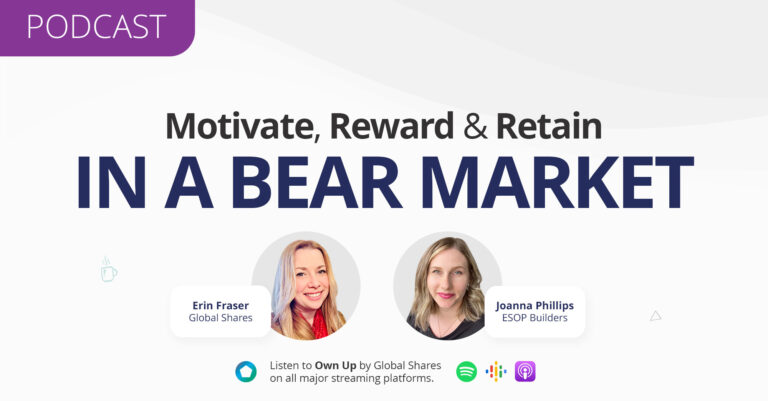Equity compensation also known as share-based or stock-based compensation, is a type of non-cash pay that a company offers to employees to partake in ownership of the firm, whether it’s a private or public company.
In this post, we’re going to discuss:
Benefits of equity compensation
The main advantage of equity-based compensation for employees is the potential financial reward. Since the value of your equity is linked to your company’s stock price, your financial benefits could be more significant than fixed cash bonuses if your company succeeds and the stock price grows.
Equity compensation also benefits employers, including:
- Recruitment and retention: Since the potential financial benefit of equity compensation is appealing, it’s commonly used to attract talent. This is particularly useful for smaller businesses looking to compete against large firms.
- Greater alignment: Having an ownership stake in the company can help align employees’ interests with the company’s missions and goals.
- Lower absenteeism: Employees tend to work harder and be more productive as their performance impacts how much they can earn.
- Employee engagement: It can improve team spirit – employees not just employees, they’re employee-owners and can often make valuable contributions to the company’s direction through shareholder voting.
- Tax benefits: Both the employer and the employee can enjoy tax benefits from some approved plans, e.g., qualified ESPP
- Better cash-flow management: Equity compensation reduces the amount paid out in cash, which could be especially ideal for companies with limited cash flow.
Equity compensation allows employers to offer their employees more – which is great for the employees – while controlling the overall impact on the bottom line, cost efficiently, and usually with tax advantages. This is also great for the employer. One important factor to note, equity compensation may not be as effective without a proper, ongoing education and communication program provided to employees. These educational efforts should include sessions on “how equity compensation works,” the future potential value, inevitable tax obligations, and a comprehensive list of FAQs, etc
Chris Dohrmann, FGE, Global Shares' SVP Of Strategic Partnerships.
Types of equity compensation
Employee equity compensation comes in a wide variety of forms and plans. Examples include stock options, restricted stock units (RSUs), employee stock purchase plans (ESPPs) and more. Here, we’ll discuss the following five types.
- Stock Options: Incentive Stock Options (ISOs) and Non-qualified Stock Options (NSOs)
- Restricted Stock Units (RSUs)
- Stock Appreciation Rights (SARs) & Phantom stock
- Performance Shares
- Employee Stock Purchase Plans (ESPPs)
Check how each works in the next section.
How does equity compensation work?
1. Stock options:
A stock option is a popular equity compensation form. It provides employees with the right, but not the obligation, to purchase company shares at an initially agreed price (i.e. exercise price) after a vesting period. Vesting is the process of earning full ownership of an award. With stock options, the value of your award will depend on how the stock price has performed against the exercise price.
There are two main types of stock options – ISOs and NSOs. ISOs provide you with tax benefits as only favorable long-term CGT is charged at sale when you sell your shares at least two years from the grant date and at least one year from the exercise date. (Notes: Alternative minimum tax (AMT) may be chargeable when you exercise your ISOs) With NSOs, you can potentially be taxed when you exercise and sell them.
2. Restricted stock units (RSUs):
Restricted stock units are a type of equity compensation with less risk as they’re typically granted for free, meaning you don’t have to purchase (i.e. exercise) the award. You earn the full-value of the shares after any vesting requirements are met.
Your RSUs will potentially be taxed when you vest and sell them.
3. SARs & Phantom stock:
SARs and phantom stock an equity form that doesn’t really use stock but still rewards employees with compensation that is tied to the company’s stock performance. So, participants are not shareholders and don’t have voting rights.
Your award depends on the appreciation of the stock value or the full stock value. Once the vesting period (usually time-based) is over, you can get a cash equivalent or the actual stock (less often the case).
You’ll potentially be taxed when you exercise and sell your award.
4. Performance Shares
Performance shares/units will vest when employees meet specific performance-related goals. These awards are frequently allocated to company executives and directors as an incentive to achieve particular performance targets.
5. Employee stock purchase plans (ESPPs):
Usually used by public companies, ESPPs allow participants to purchase stock in their companies at a discount – often between 5-15% off the fair market value (FMV).
The way they do this is by making contributions directly from employees’ paychecks using after-tax dollars over a set period of time. Their accumulated contributions are used to buy company shares at the purchase date.
With non-qualified ESPP, you’ll be taxed when you purchase and sell your shares. With qualified ESPP, you’ll only be taxed when you sell your shares.
Potential problems with employee equity
Although equity compensation is popular across different industries, the main disadvantage that we usually hear about is the matter of complexity.
- A lot of reporting and regulations to follow, as well as entire areas of jurisdiction and tax laws to consider
- A tremendous amount of work and thought that needs to be put into the design of the plan
- Extra equity plan administration workload to your existing departments – everything from tracking and reporting changes in ownership to updating documents/policies/procedures, communicating with stakeholders, consulting your board of directors, and staying compliant.
Luckily, there’s a solution to this: Global Shares – Automated cloud-based equity compensation management software.
Looking to launch an equity compensation plan? Contact Global Shares today
Supported by our technology and a team of equity professionals, we can take on all the complexity and the hard work of management required for your equity compensation plan.
Global Shares Reviews
Our teams of professionals will take you through implementation, where we work with you to design and launch your plan, as well as the day-to-day business of maintaining and improving your plan after launch.
Our intuitive, automated equity compensation software makes it easy for corporate admin users and participants to view and manage their equity 24/7 without a steep learning curve.
Contact Global Shares for a free demo today.
FAQs about employee equity compensation
What is equity compensation?
Equity compensation, also known as share-based compensation, is a type of non-cash pay that a company offers to employees to partake in ownership of the firm. Some examples are stock options, restricted stock, stock appreciation rights (SARs) and ESPPs.
Why equity compensation?
The major advantage of employee equity compensation is the financial considerations both for the employer and the employee. It allows employers to offer their employees more – which is great for the employees – while not affecting their bottom line – which is great for the employer.
How does equity compensation work?
Equity compensation works by offering employees equity right away when they join the company or offering them a form where employees have to stay with the company for a certain amount of time to have full ownership of the stock.
How much equity to give employees?
Startups typically create employee equity plans that comprise 10–20% of the total equity of the company (50% for the founder(s) and 30-40% for investors).












